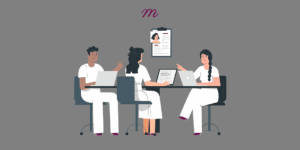As a therapist, I’ve seen firsthand how the simple act of planning can evoke a wide range of emotions in clients. Where some find clarity and direction, others struggle with feelings of overwhelm or inadequacy. My goal in developing treatment plans is never to add undue pressure, but rather to partner compassionately with clients in charting a hopeful course. This should also be the goal of each and every therapist when drafting a treatment plan.
A good treatment plan can make all the difference in a therapeutic journey – but creating one that’s truly personal takes time. A good plan reflects the client’s needs and goals while also showcasing the therapist’s commitment, allowing their voice, style, and approach to come through. Mentalyc makes this easier, helping you shape plans that feel authentic, personal, and clearly connected to the journey ahead.
Each individual’s needs are unique, so a one-size-fits-all approach will not do. Through open dialogue and care for the whole person – mind, body and spirit – our aim as therapists should be to gain understanding, then prioritize our clients’ personally meaningful targets. At each step, clients remain in the driver’s seat with full autonomy over pace and process.
This collaborative spirit is what I’ve found most conducive to healing. By working as a united team focused wholly on the client’s vision of wellness, obstacles that once felt insurmountable can break down into approachable, doable tasks. Bit by bit, challenge by challenge, stability and joy may take root where once sadness prevailed.
What is a Treatment Plan? A Detailed Definition
So, if you’ve ever dipped your toes into therapy or are thinking about it, you’ve probably heard the term “treatment plan” tossed around. But what exactly is it?
A treatment plan is essentially the therapy roadmap. Imagine you’re planning a road trip. The client’s diagnosis is like the starting point on the map, showing where you are right now. The treatment plan? That’s the route, guiding to the destination: therapy goals. It’s a collaborative effort between the therapist and the patient, kind of like planning the trip with a friend who knows all the best stops along the way.
At its core, a treatment plan is a collaborative document created by the client and clinician to guide the therapy process. Early in working together, they discuss the challenges currently facing the client and what outcomes would represent an improvement in well-being or daily functioning. The treatment plan is a set of written instructions and records that detail how to tackle the client’s challenges to achieve his/her therapeutic goals. It includes the client’s personal info, diagnosis (or diagnoses, because mental health can be complex), and a general outline of the treatment prescribed.
Specific, measurable goals are established along with approaches the clinician believes may help achieve those aims based on their training and the client’s needs. Progress will be regularly reviewed to determine if adjustments are warranted.
By developing a shared understanding and written record of the path ahead, rapport is strengthened as client and clinician work as a team. The client feels heard and invested in their own recovery. The plan provides structure while allowing flexibility. To elaborate, the treatment plan can be updated when life brings changes to reflect what is most important now.
Treatment planning puts the client’s priorities at the center. When therapist and client are aligned in their vision, motivation remains high and goals thereby are achieved.
What Does a Treatment Plan Contain? (Key Components for Therapy & Insurance)
To ensure that your treatment plan ticks all the boxes for insurance carriers, double-check the following key requirements:
1. Session Details in a Counseling Treatment Plan
For insurance purposes, the treatment plan must include:
- Start and Stop Time: Duration of each session.
- Place of Service: Location of the session (e.g., home, office, telehealth).
- Date of Service: When the session took place.
- Patient Identification: Name and a second unique identifier (e.g., date of birth).
- Provider Information: Name and credentials of the therapist.
2. History, Assessment, and Demographics in Therapy Planning
This foundational section includes:
- Basic Demographic Information: Age, gender, occupation, etc.
- Psychosocial History: Family background, social interactions, and lifestyle.
- Onset of Symptoms: When symptoms first appeared.
- Diagnoses: Past and present mental health diagnoses.
- Treatment History: Previous treatments and their outcomes.
- Assessment Information: Any other relevant assessments that impact well-being.
3. Presenting Concerns in a Mental Health Treatment Plan
This section details the current mental health issues and concerns that led the individual to seek treatment. It’s a snapshot of the immediate problems that need to be addressed.
4. Treatment Contract
The treatment contract outlines:
- Goals for Change: Mutually agreed-upon objectives.
- Responsibilities: Who is responsible for what.
- Treatment Modality: The type of therapy or intervention to be used.
5. Identifying Client Strengths in Therapy Plans
Highlighting the individual’s strengths can empower them to use these attributes to achieve their goals. This section includes:
- Perceived Strengths: Skills, talents, and positive traits.
- Utilization: How these strengths can be used in treatment.
6. Modality, Frequency, and Targets in Counseling Treatment Plans
Each goal in the treatment plan includes:
- Treatment Modality: The type of therapy (e.g., CBT, DBT).
- Frequency of Sessions: How often sessions will occur.
- Target Dates: Specific dates for achieving goals.
7. Treatment Goals
Goals are the cornerstone of the treatment plan. They should be:
- Specific: Clear and detailed.
- Realistic: Achievable within the individual’s capabilities.
- Tailored: Customized to the individual’s needs.
- Measurable: Using rating scales, target percentages, and behavioral tracking.
8. Objectives
Objectives break down larger goals into smaller, manageable steps. They provide a clear path to achieving the main goals.
Setting clear goals & objectives is a vital part of the treatment planning process, but it can often feel overwhelming. Insurance requirements ask for goals to be SMART – specific, measurable, achievable, relevant, and time-bound – which isn’t always easy to create or put into words. Mentalyc supports therapists by analyzing sessions and suggesting measurable goals tailored to each client and therapeutic approach, making it easier to create meaningful, audit-ready treatment plans.
9. Interventions
This section details the techniques and interventions the mental health professional will use to support goal achievement. It includes:
- Techniques: Specific methods and strategies.
- Implementation: How these techniques will be applied.
10. Progress and Outcomes
Documenting progress is crucial. This section includes:
- Progress Toward Goals: Tracking achievements and setbacks.
- Outcomes: Summarizing the results of the treatment.
- Clinical Progress Notes: Detailed notes on the individual’s progress.
11. Client and Provider Signatures
The treatment plan is a formal agreement between the client and the therapist. Both parties sign to show their awareness and consent.
A Treatment Plan Does Many Things
How can I know if my treatment plan does the job? Ask yourself the following questions:
Does my treatment plan
- Define the specific concerns or symptoms bringing the client to therapy?
- Outline the proposed therapeutic interventions and overall approach tailored for the client’s needs?
- Set an estimated timeline for treatment, including durations, progress assessment intervals and planned evaluations?
- Identify concrete, measurable goals and objectives for the client to work towards?
- Note important milestones that will mark progress in therapy?
- Formalize mutual understanding between clinician and client for a clear, focused path forward in therapy?
- Help clinician and client monitor and track progress towards defined goals and symptom reduction?
If this feels overwhelming to do manually, Mentalyc can create a complete treatment plan instantly with a single click. The platform suggests interventions and goals tailored to the client’s needs and helps you track evolving progress over time—so your plans grow with your clients,
Who Can Benefit from Treatment Plans?
So often in practice I’m reminded that struggle and suffering know no bounds. Clients have graced my door from all walks representing a vast array of human experience:
- Individual Adults: Those struggling with depression, anxiety, bipolar disorder, trauma/PTSD, addiction, eating disorders or self-harm behaviors. Plans target symptom reduction.
- Adolescents: Youth dealing with depression, disruptive behaviors, substance use, suicidal thoughts, trauma or neurodevelopmental concerns like ADHD. Plans support healthy coping and development.
- Children: Kids experiencing behavioral/emotional problems, traumatic stress, parental psychiatric issues or complications from medical conditions. Early intervention helps.
- Families: Those managing interpersonal conflicts, divorce/separation, parenting challenges, caregiving demands or crises. Plans strengthen support systems.
- Older Adults: Individuals adjusting to retirement, declining health, loss of independence or caregiver responsibilities. Plans prioritize wellness and quality of life.
- Couples: Partners navigating communication struggles, infidelity, blended family adjustments or co-occurring disorders. Plans facilitate emotional regulation.
- Individuals with Disabilities: Those managing physical, cognitive, intellectual or developmental disabilities. Additional needs are addressed.
- Marginalized Groups: People facing discrimination due to race, ethnicity, gender identity, sexual orientation or socioeconomic status. Plans counter minority stress.
- Employees (and yes, even therapists!): Workers managing occupational stress, burnout, executive functioning issues or behavioral health benefits from employers. Plans support productivity.
Factors to Consider
For no two journeys are identical, as no two souls who walk them. So we draw not upon prescribed protocols but open-hearted partnership, honoring autonomy over anonymity.
While certain presenting issues may lead clinicians to consider comparable interventions, no two treatment plans will ever be exactly the same. A few key reasons for this:
- Individual Factors: Even among those with a shared diagnosis, every person’s life experiences, personality traits, family/social support systems, medical history and current circumstances differ in meaningful ways.
- Client Preferences: Engaging the client in shared decision-making leads to approaches they feel invested in. Their values, definitions of well-being and openness to certain therapies shape optimal care.
- Cultural Lens: One’s culture informs how they understand distress and seek help. Culturally-informed plans foster empowerment through customary healing methods when possible.
- Comorbidities: Co-occurring medical, psychological or social issues layered with the presenting problem necessitate customized plans.
How to write a treatment plan?
If you’re a mental health professional, writing good treatment plans can feel overwhelming, and you may not know where to start. Mentalyc Inc. recently surveyed active users to assess what they are using to create treatment plans.
One key finding from the survey about treatment plan templates includes:
- 1/3 of users use Wiley Treatment Planners
- 1/3 of users design their own treatment plans
- 1/3 of users use a different template that isn’t Wiley
Treatment plans must also include required information from insurance companies to determine the medical necessity for treatment. You should also consider how you are tracking your client’s progress. You will want a treatment plan format that makes it easy to follow the client’s established goals and objectives for therapy.
Tips for writing effective treatment plans
Here are some tips for writing effective treatment plans:
- Pull your information from the intake assessment
- Use client quotes of what they want to work on for their goals
- Be detailed about the interventions you will use
- Add a timeframe to the goals stated
- Have measurable objectives to determine the client’s progress
- Write about the client’s progress in your treatment plan
Treatment plans are a collaborative process between you and the client. The more client input you can gather, the better.
Why are treatment plans useful?
Psychotherapy should be client-focused. Treatment plans give you a place to write about why the client is there and what they want to accomplish in short-form and long-term goals.
Additionally, treatment plans help you tailor your interventions to the client’s needs. You allow the client to identify their target objective and treatment goals and describe how they can reach them.
How Often Shall a Treatment Plan be Updated
While plans should remain flexible to adjustment as needs evolve, regular evaluation helps ensure our work stays anchored yet nimble.
Some counselors schedule formal reviews monthly or bimonthly early on, when change perhaps comes swifter.
Personally, I find value in longer stretches between check-ins – say, 3 to 6 months.
This allows natural ebbs and flows time to surface as patterns versus passing fancies. It also honors each journey’s pace without undue scheduling pressure.
Of course, significant life shifts may warrant conversation before planned review. And clients feel empowered knowing they can always request discussion as interests or priorities shift.
When you update a treatment plan, you will want to evaluate your client’s progress on their original goals. If your client has met their initial goals, you will want to note their progress. In many EHRs, you can copy and paste the old treatment plan, update goal progress, and add new smart goals if necessary.
If a client’s diagnosis has changed since their initial treatment plan, you will also want to update their diagnosis. However, it may be best not to delete the original treatment plan because it can show your client’s progress in the first few months of therapy.
Updating your treatment plans is essential for tracking client progress and shifting directions in therapy if needed. Your client may have new goals and objectives after a few months that they want to work.
Treatment Plan Example 1
💡 Client Name: George Smith
DOB: 5/11/1988
Age: 35
Date: 2/1/2023
Start and end time: 1:00pm – 1:50pm
Location: telehealth session via encrypted video
Diagnosis: Generalized Anxiety Disorder
Presenting Concern: George experiences overwhelming worry and tension related to his work. He describes difficulty sleeping, trouble concentrating, and health issues due to stress. George’s anxiety has escalated since changing to a new job and working remotely. He is committed to developing coping skills to feel more in control and less burdened by anxiety so he can fully engage at work without adverse impacts on his well-being.
Goal: Within 6 months, George will acquire and utilize strategies to manage work-related anxiety effectively so it no longer negatively affects his job performance, health, or ability to enjoy life.
Objective 1: By our 10th session, George will identify and begin challenging anxious self-talk using cognitive restructuring techniques.
Approach: I will provide psychoeducation on cognitive distortions and adaptive thinking. Together we will notice George’s thoughts during anxious episodes and work to evaluate them objectively rather than automatically.
Objective 2: By our 15th session, George will consistently implement three relaxation or mindfulness skills to help calm his physical anxiety response and stay present rather than dwelling on worries.
Approach: We will explore various grounding, relaxation and acceptance-based exercises to build George’s coping toolbox. I will encourage regular informal practice as well as follow-up discussions to reinforce his options for self-soothing anxiety.
George Smith (electronic signature) 2/1/2023
Counselor Name, Credentials (electronic signature) 2/1/2023
Treatment Plan Example 2
💡 Client Name: Robert Johnson
Date of Birth: 4/3/1990
Current Date: 3/15/2023
GOAL:
Robert will develop an improved system for parenting his child that results in more positive behavior, rated at least 7 out of 10.
OBJECTIVES:
Robert will identify clear household rules and expectations. Robert will outline an organized system of rewards and consequences. Robert will present the new structure to his son through open communication. Robert will consistently uphold the system and evaluate its impact.
INTERVENTIONS:
I will provide psychoeducation on effective parenting strategies to support Robert’s framework. Together we will generate the rule lists, rewards/consequences using worksheets. I will coach Robert to have an empathetic yet firm discussion explaining the changes. Our weekly check-ins will reinforce adherence and problem solve barriers through objective feedback.
PROGRESS:
Over the past month, Robert completed objectives 1-3. He noted his son adjusting well with increased enthusiasm. Both parties rated progress towards this goal as a 5. Maintaining consistency through objective reviews aims to further optimize family well-being.
Robert Johnson (electronic signature) 3/15/2023
Counselor Name, Credentials (electronic signature) 3/15/2023
Treatment Plan Example 3
💡 Client Name: Michael Jones
Date of Birth: 5/12/1993
Current Date: 6/15/2023
Presenting Concern: John discusses challenges managing attention, initiating tasks, relating to others and reacting to stressors which impact his daily life and work. John is a 28-year-old male.
Diagnosis: John has received an ADHD diagnosis in the past.
Goal: John aims to develop coping strategies for focus, organization and relationships through open dialogue.
Objectives:
Identify 3-5 techniques to start and sustain work tasks. Recognize sensory triggers and test relaxation methods. Consider neuropsychological testing and related referrals if needed.
Approach:
We will have holistic discussions. John will learn approaches such as goal-setting, background noise and accountability partnerships. Trigger awareness and grounding skills will be explored. The option of further assessment will be respectfully weighed considering John’s priorities.
Strengths: John is socially supported and invested in better well-being through collaboration.
Area of Growth: John may benefit from financial capability discussions to address access barriers.
Potential Referrals: Neuropsychological evaluation details will be provided respecting affordability and choice. Psychiatric care options will be explored should testing indicate a medication referral aligns with treatment preferences.
Michael Jones (electronic signature) 6/15/2023
Counselor Name, Credentials (electronic signature) 6/15/2023
Treatment Plan Example 4
💡 Client Name: John Doe
Client ID: 12345
Date of Birth: 4/3/1990
Date of Plan: 7/8/2023
Date of Most Recent Diagnosis: Major Depressive Disorder, 7/1/2023
Problems/Needs Identified:
John reports depressed mood most days. Lack of motivation and challenges maintaining hygiene. Social isolation due to low energy/self-esteem.
Strengths and Resources:
Good relationship with supportive mother. Compliant with medications in past. Employed part-time with flexible schedule.
Cultural Considerations:
John identifies as LGBTQ+. Provides emotional support through local community center activities.
Goal #1: Improving mood and self-care.
Objective: John will rate mood at least 5/10 on daily scale for 30+ days.
Strategies: John will use coping skills and track mood. Nurse will monitor hygiene, medications.
Goal #2: Increasing social engagement.
Objective: John will attend 1 community center event/week for 6+ weeks.
Strategies: Practitioner will assist John in exploring interests and overcoming barriers.
Referral(s): Psychiatrist as needed for medication management.
Coordination: Mother assists with transportation/attendance. Community Center for additional support.
John Doe (electronic signature) 7/8/2023
Counselor Name, Credentials (electronic signature) 7/8/2023
Example of a treatment plan for a client with anxiety
Problem: Bob is a 42-year-old male who works as an accountant. He reports an increased workload at his place of employment and is having trouble keeping up with his demanding workload. Due to increased stress, he dreads going to work. When he thinks about how behind he is, he feels overwhelmed and tends to shut down and avoid work. He reports feelings of constant dread. He feels sweaty and has difficulty focusing when approaching a task. Bob has sleep difficulties and constantly worries about work, especially at night. He says that he has thought loops where he obsesses over work repeatedly. Bob has withdrawn from his significant other and often does not want to leave the house anymore. He worries that his significant other will be upset if he loses his job.
Diagnosis: Bob has a diagnosis of Generalized Anxiety Disorder.
Goal: Bob wants to reduce his overall anxiety and see improvements within the next six months.
Objective(s):
- Bob will learn three skills to help assess and manage his anxiety.
Intervention and Modality:
Bob will use a CBT thought record to record his anxious thoughts. Then, Bob will work on replacing his anxious thoughts with more helpful thinking patterns by identifying cognitive distortions. Next, the clinician will educate the client on Generalized Anxiety Disorder. Finally, the clinician will model skills for the client to help reduce overall anxiety, such as thought-stopping, meditation, breathing techniques, and tapping exercises.
Strengths: Bob consistently shows up for appointments. Bob states, “I’m willing to try any skills necessary to help reduce my anxiety.”
Areas for improvement: Bob lacks consistent social support except for his wife.
Referrals: Bob will be referred to his primary care physician for anxiety medication.
Example of a treatment plan for a client with ADHD
Problem: Stacy presents for therapy, wanting to work on symptoms associated with what she believes to be ADHD. Stacy is a 25-year-old female. Stacy states that she has had problems focusing at work and completing tasks promptly. Stacy works as a paralegal and has a lot of paperwork to deal with. She reports that she has had trouble doing her work over the past few months. She has difficulty initiating tasks and often finds that she can’t complete tasks unless there is a sense of urgency or a deadline approaching, causing her to procrastinate. Stacy also states that she is having relationship difficulties with her partner. She reports that her partner listens to their music loudly most nights of the week, and it is hard for her to feel relaxed in her home. Stacy says that when it is too loud, she often snaps, yells at her partner, and wishes for “some peace and quiet.”
Diagnosis: Stacy has a diagnosis of ADHD.
Goal: Stacy wants to learn ways to cope with ADHD and how to initiate and focus better on her work tasks. Stacy also reports wishing to get along better with her partner and deal with overwhelming emotions more effectively.
Objective(s):
- Stacy will learn 3-5 new skills she can implement to assist with task initiation and focusing on tasks.
- Stacy will learn what triggers sensory overload and three methods for coping with sensory overload.
- Stacy will undergo a neuropsychological assessment to confirm the diagnosis of ADHD and assist with a possible medication referral.
Intervention and Modality: The therapist will employ a holistic approach to treating the client’s ADHD. The therapist will teach Stacy skills such as body doubling, setting timers, making a game out of tasks, and having an accountability partner for task initiation and focus. The therapist will explore sensory overload with Stacy, teach her what it is, and discuss tools that may be effective for limiting sensory input. The therapist will also model effective strategies for Stacy that may help when sensory input can’t be limited, such as meditation, tapping techniques, and deep breathing exercises. The therapist will explore Stacy’s attitudes regarding receiving a full neuropsychological assessment to obtain medication. The therapist will provide Stacy with the appropriate referrals for the evaluation.
Strengths: Stacy has adequate social support, such as friends, family members, and her partner, that supports her mental health. Stacy is willingly engaged in treatment and eager to learn and implement new strategies that may be helpful to her.
Areas for improvement: Stacy lacks financial management skills due to her ADHD; therefore, managing money and affording a neuropsychologist referral may be difficult.
Referrals: The therapist will refer Stacy to receive a neuropsychological assessment to confirm her diagnosis of ADHD and also assess for any additional mental health diagnoses. Her assessment results will be used to refer her to a Psychiatrist or Primary Care Physician for potential medication for her ADHD.
What do insurance companies require in treatment plans?
When you write treatment plans, you should always check the requirements of the insurance companies you’re working with. Each insurance company may have different requirements. What’s important is that the insurance company can see a medical need for the client to receive treatment from the therapist—also known as a medical necessity.
Proving medical necessity may be tied to a client’s challenges at work, school, or relationships. You might ask yourself, “Why does the client need therapy?”
So, you may wonder what insurance companies require in their treatment plans?
Many insurance companies require these sections:
- A diagnosis
- Goals and Objectives
- A timeframe for goals and objectives
- How many sessions it will take to achieve the set goals
- Therapist interventions
- Therapist modalities
- An overview of the client’s progress.
Some insurance plans require that treatment plans be updated every three months. According to a survey of active Mentalyc users, updating treatment plans at the 3-month mark is the most common, followed by treatment plan updates every six months.
Why Trust Mentalyc When Creating Your Treatment Plan
Trusting Mentalyc is a no-brainer for mental health professionals seeking efficiency, compliance, and quality in their practice.
With over 11,000 psychotherapy professionals already benefiting from its AI-powered note-taking capabilities, Mentalyc has proven its reliability and effectiveness.
The platform is 100% HIPAA-compliant, ensuring that your client data remains secure and confidential.
By automating the tedious task of writing progress notes, Mentalyc allows you to focus more on what truly matters: providing exceptional care to your clients.
Recap
Treatment plans serve as a guide for therapy. Treatment plans should tell you the therapist’s roles and responsibilities and the client’s roles and responsibilities. Treatment plans have many necessary sections for insurance purposes and should be updated every 3-6 months to examine the client’s progress and per insurance companies’ requirements. Treatment plans should be a client-focused collaborative process that provides a clear path of how the client can reach their goals. Strengths and potential barriers to progress should be explored as this can help plan for any obstacles that can get in the client’s way of reaching their goals.
We know that creating treatment planning can be demanding, but it can also be really useful tool – even if you don’t bill insurance. With Mentalyc, you don’t have to spend time writing treatment plans. We analyze your sessions and create tailored plans that align with your therapy approach, suggesting goals and interventions along the way. You always have full control over the final shape of your plan. Plus, every note you take links back to the goals in the plan, so you always know how progress is going. Let’s give it a try!
Updated by: Salwa Zeineddine
Why other mental health professionals love Mentalyc

“It immediately changed my quality of life, personally and professionally. I went from 3–4 hours a week of notes to 1 hour at most … that alone is invaluable personally and professionally.”
Owner/Independently Licensed Marriage & Family Therapist (IMFT)

“For those who have hesitations … It is a lifesaver. It will change your life and you have more time to be present with your patients.”
Licensed Clinical Social Worker

“If I were recommending this software to a colleague, I would tell them that it is the best thing that they could do for their practice.”
Licensed Professional Counselor

“Do yourself a favor, make your life easier. Use the tools that are readily available … I found Mentalyc to be one of the best tools that I’ve ever used.”
Licensed Marriage and Family Therapist







